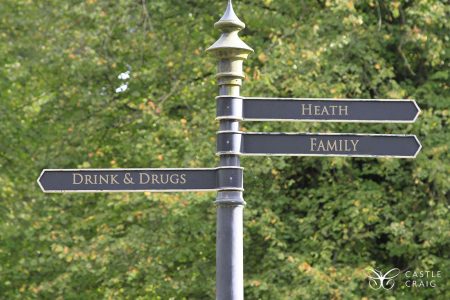Table of Contents
In a healthy, functional family, support is a given. Dealing with the inevitable trials and tribulations of life becomes much more manageable knowing you have the support of your family to rely upon.
However, when one person in the family unit develops an addiction, whether a drug addiction, alcohol addiction or behavioural addiction, this support can become warped. While we all naturally want to support our loved ones through hardships, help can easily slip into enabling when it comes to addiction.
In this article, we look at the difference between helping and enabling, as well as some of the most common signs you are enabling addiction. We’ll explore two of the most common types of enabling, along with some of the consequences you might experience as a result of enabling addiction. We finish up by looking at how to stop enabling and how you might benefit from engaging with family therapy.
If you are worried about a friend, partner or family member’s drug or alcohol addiction, you can get help for your loved one at Castle Craig. We are experienced in assisting with interventions and reassuring individuals who feel ready to engage with our residential therapies. Call 01721 546 263 to speak to an advisor about our inpatient treatment plans for someone you care about.

Download Our Brochure
Enabling Vs Helping Your Loved One
But what exactly is the difference between helping and enabling? Helping is doing something for a loved one which they are unable to do themselves. Enabling is doing something for a loved one which they can, and should, be doing themselves.
For example, if your loved one loses their driving licence because of their addiction you could help them by driving them to treatment. In this scenario, enabling them might involve helping them to research how to get their licence back or indulging them in a conversation where they lament the unfairness of the situation.
With this distinction, you can see how enabling creates a family culture in which the person with an addiction is able to carry on with their unacceptable behaviour.
While enabling is commonly seen in families struggling with addiction, it can happen in all manner of families. A person is enabling when they allow any type of negative pattern of behaviour to continue within a relationship.

5 Signs You’re Enabling Your Loved One’s Addiction
Unfortunately, enabling often ends up getting in the way of recovery. Without having to face the natural consequences of their actions, people with addictions are able to carry on in their lives safe in the knowledge that they will be cared for, and enabled, by their families.
While there are steps you can take to help your loved one recover (though it’s important to note, it is ultimately their decision and responsibility), enabling their addiction is not a good strategy.
It can be tricky to know where the boundary lies between being helpful and enabling, so below we have outlined some of the most common signs you might be enabling addiction.
Making Excuses
Do you regularly make excuses for your loved one, or cover up their behaviour? This is a classic sign of enabling. By excusing their behaviour you are minimising it and sheltering them from the ramifications of their actions.
For example, you might ring up their workplace on their behalf and say they are sick when really they are too hungover or intoxicated to attend work. Or, at a family gathering, you might smooth over their embarrassing behaviour by making excuses for it (“she’s had a difficult week at work”, “his partner has just left him so he’s feeling fragile”), or by reassuring them the next day that they didn’t embarrass themselves.
It’s understandable behaviour, but it isn’t helpful in terms of helping your loved one recover. You need to help them see the real fallout from their behaviour, and allow them to deal with the consequences independently.
Funding
Do you fund your loved ones’ lifestyle? That could mean giving them money or allowing them to live in your house and eat food rent-free and without contributing to the household. If so, this too could be a form of enabling.
By funding the addicted person’s lifestyle you are buffering them from the realities of life and robbing them of the chance to develop more self-reliance. If they know you’ll provide them with money, or at least shelter and food, there is no incentive to keep their job. By giving them money, you might also be directly funding their addiction, too.
It might sound harsh, but sometimes a person might need to run out of money before getting treatment for their addiction seems like an attractive prospect.
That’s not to say you need to kick your loved ones out, but you could put some boundaries in place. For example, they can stay at your house but they will need to contribute to household tasks and actively look for a job.

Safe Detox in Comfort
No Boundaries
Do you allow your loved one to act in whatever manner they deem acceptable? Perhaps you moan about it, but you don’t actually do anything to stop it happening again in the future?
For example, perhaps your family member regularly indulges in their addiction in your house or invites people over who you are not comfortable with.
If this is your experience, you may have a lack of boundaries and that can be a form of enabling. When it comes to supporting a loved one with an addiction, boundaries are essential. This is particularly important if you want to look after your wellbeing and not end up feeling bitter and resentful (we’ll talk more about this later).
Setting boundaries is healthy and it’s a way to let your loved one know you love them, but not their behaviour. Boundaries look like telling your loved one you will not allow drinking or drug taking in your house, and then following through with this.
Protect them from consequences
Do you regularly clean up your loved ones’ messes? Shielding them for the consequences of their actions might make them happy and it might feel good in the moment, but ultimately it won’t help them get sober or recover.
For many people who are addicted, it is only when they have to face the consequences of their behaviour that they start to think about getting help.
Their problems become yours
Do you feel like your loved ones’ problems are your problems? Do you regularly centre your loved one with an addiction? Perhaps this is done at the detriment to other family members and even yourself.
Enabling addiction is often a logical extension of codependency. Codependency is when one person develops an unhealthy level of reliance on another person. This relationship pattern usually forms because the person providing the “help” is getting something out of it too (this could be anything from the role of ‘saviour’ to simply deferring dealing with their own problems).
If you are feeling so strongly enmeshed with your loved one that you feel their problems are yours, it could be a clear sign to take a step back. While it is natural to want to help your loved ones, you have to understand that you are not responsible for their problems or behaviour and that change can only come from within.
Fear-Based Enabling
Your motivation for enabling your loved one’s addiction may stem from fear, which is known as fear-based enabling. Perhaps your loved one has said things in the past that have caused you to develop this fear. For example, they could have threatened to cut all ties with the family or take their own life. Because you are concerned about their safety and welfare, you continue to enable their behaviour out of fear.

Hope-Based Enabling
At the other end of the spectrum is hope-based enabling. This form of enabling often results when a loved one constantly seems on the edge of getting help. Because you don’t want to get in their way or stop them making any positive progress, you continue to enable them in the hopes that they will get help soon. Sadly this promised progress is often just a lie to allow them to continue being enabled.
Resentment
By now you can tell if you’re engaging in enabling and you might understand some of the reasons for doing so. While it is an understandable reaction to a loved one going through an addiction, hopefully you have recognised that in the long-term it isn’t helpful and it can actually delay the person in question getting treatment.
But there is another downside to enabling too, and that is what it will do to you over time. By continually enabling addiction, you will likely grow resentful. As time ticks on and, despite all your best efforts, the person hasn’t got any help or made any tangible progress, you will start to feel bitter that you have given them so much in return for nothing.
However while this reaction is understandable, it isn’t particularly fair. Without having to face the consequences of their addiction, your loved one will likely remain unmotivated to change. If you constantly enable them in their addiction, you have to accept the role you are playing in maintaining the status quo.
In order for things to change and to release yourself of resentment, you need to accept that the only person you can control is yourself. And in this case, that means stopping the enabling behaviour.
Blaming Situations And Others For The Person’s Actions
Another common mistake people make when enabling addiction is to absolve their loved one of any blame in their addiction, instead choosing to blame external situations or other people.
Again, it is an understandable reaction. It isn’t pleasant to think that your loved one has played a prominent role in developing an addiction and is, ultimately, responsible for resolving it. But developing this mindset is much healthier than constantly blaming external factors.
It is also a more hopeful outlook. If you accept that your loved one is fully responsible for developing their addiction – not a certain situation or other people – then you can have more faith in them to resolve the issue too.
I am here for Alcohol | Drugs | Other Addiction
How to Stop Enabling
If you’ve got to this point, you might be keen to learn how to stop enabling your loved one with an addiction. The good news is, it doesn’t mean removing all support and help!
As we discussed earlier, it simply means avoiding doing things for them that they could do for themselves. Not only can this help your loved one to see the value in getting help, but you may notice your own mental health and sense of wellbeing improve too as you no longer focus solely on the other person.
- Have a Frank Discussion
If you haven’t acknowledged the problem in a clear manner before, now is the time to talk to your loved one about their addiction. Make it clear you know about their problem, emphasise that while you don’t love the behaviour you love them and reassure them you are available to support them when they are ready to make a change.
- Establish Boundaries
Create some boundaries, communicate them clear and then – and this is the important bit! – follow through when your boundaries are violated. If you don’t do the last part, they will quickly realise you aren’t serious and business as usual will resume.
- Help Don’t Enable
Remember the difference between helping and enabling and vow to only help in the future. That means don’t do things for them that they are capable of doing for themselves.
- Stop Funding
If you do give your loved one money, make it clear that you are unable to provide them with any more money going forward. This will allow the person to become more self-reliant and have to deal with the consequences of their addiction.
- Stop Protecting Them
If their addiction results in unfavourable consequences, no longer shield them from them. This isn’t easy, but it is vital so that your loved one comes to understand the extent of their problem.
The Link Between Enabling and Codependency
Codependency often looks like an imbalanced relationship. So it’s common for one person to sacrifice their own needs and feelings in order to meet the other person’s needs. Both parties are getting something out of this arrangement. The person who is being taken care of is obviously benefiting, but the person doing the ‘helping’ is also getting something out of the relationship, such as the feeling of being needed.
As we discussed earlier, enabling is often born out of a codependent relationship. While it can happen between romantic partners, it can also happen between family members and even friends. Unfortunately this type of relationship pattern is not healthy and it can lead to all sorts of problems, including enabling.

Family Therapy
You can see how addiction is impacted not just by the individual with the addiction, but by the family unit that they live within. For example, those that are enabled in their addiction may continue to be addicted for longer, only seeking help when their family reaches the end of their tether.
Because of this link, and the vital role that family plays in successful recovery, family therapy is often an integral part of treatment.
Family therapy isn’t about blame. Instead, it focuses on fostering good communication, rebuilding damaged relationships and educating everyone about the disease of addiction. From here, the family can better understand the behaviours of the addict and cope more effectively with the problem of addiction.
If you’re interested in learning more about addiction treatment, including family therapy, contact our friendly team on: 01721 546 263
CATCH Recovery is a leading outpatient clinic in London that provides exceptional addiction treatment services for patients struggling with substance misuse disorders. The clinic offers personalized treatment plans that are tailored to meet the unique needs of each patient, with a team of highly trained and experienced addiction specialists who work closely with patients to help them achieve long-term recovery.
FAQs
How Do You Know if You Are Helping or Enabling?
Helping is doing something for someone that they are unable to do themselves. Enabling is doing something which they can, and should, be doing themselves.
What Is Enabling in Addiction?
Enabling an addiction includes behaviours like funding their lifestyle, shielding them from the consequences of their actions and making excuses for them.
When Helping Becomes Enabling?
Helping becomes enabling when you start doing things for other people which they can, and should, be doing for themselves.
What Are the Four Types of Enabling?
Two of the most common kinds of enabling are fear-based and hope-based enabling. There is also guilt-based and victim-based enabling.



